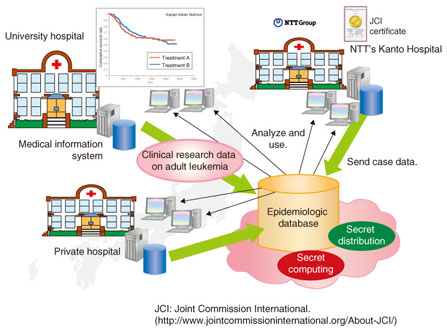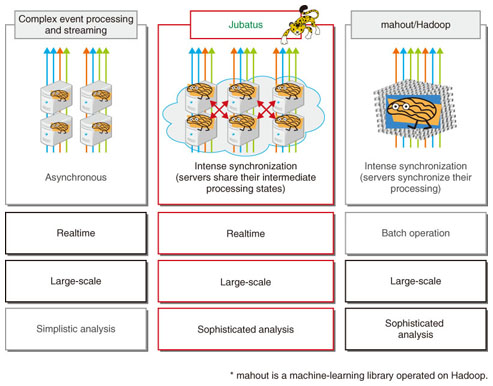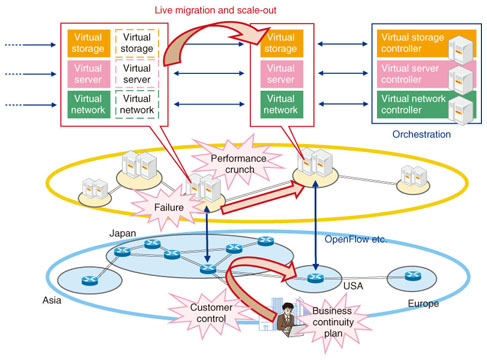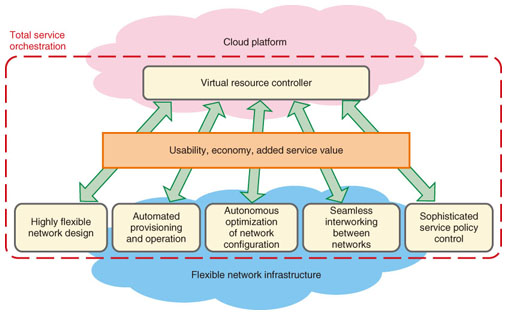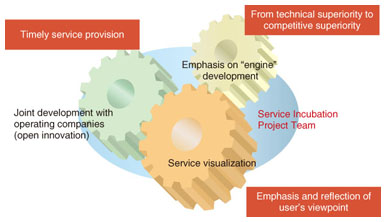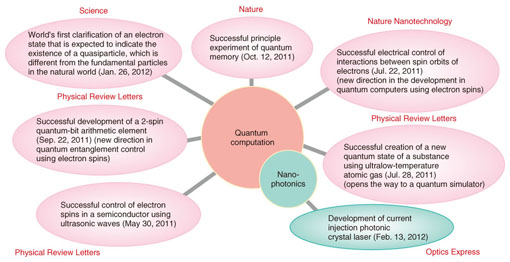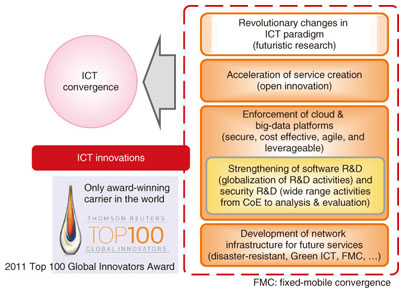 |
|
|
|
|
|
Feature Articles: Keynote Speeches at NTT R&D Forum 2012 Vol. 10, No. 4, pp. 10–21, Apr. 2012. https://doi.org/10.53829/ntr201204fa2  R&D to Create the Future of ICTAbstractThis article introduces NTT's research and development (R&D) activities aimed at making further innovations in order to move on from the Great East Japan Earthquake of March 2011 and create the future of information and communications technology (ICT). It is based on the lecture given by Hiromichi Shinohara, NTT Senior Vice President and Director of the Research and Development Planning Department, at NTT R&D Forum 2012, held on February 15–17, 2012. 1. One year after the Great East Japan EarthquakeThe earthquake that hit East Japan on March 11, 2011, and the tsunami that followed it caused severe damage to NTT's telecommunications facilities, destroying and flooding buildings, breaking cables and conduits, and felling the concrete masts of base stations for mobile communications. The services provided via about 400,000 fixed lines and about 2000 base stations were disrupted immediately after the earthquake and tsunami. The damage for fixed lines grew and peaked two days afterwards at about 1.5 million, while the damage for base stations peaked one day after the earthquake at about 6700 base stations. This was because NTT's batteries and generators sustained local power supply for some time after the outage of the commercial power supply, but then the batteries ran flat and the generators ran out of fuel so they could no longer support communication. 1.1 Issues that needed to be addressed by NTT's R&DConfronted with this situation, the NTT Group worked together to restore service by rushing vehicle-mounted power generators and fuel to the stricken areas, but this all-out effort left much room for improvement because the commercial power outage lasted longer and affected wider areas than NTT had ever imagined and because it was necessary to prepare for the scheduled rolling power blackouts implemented in areas beyond the disaster-stricken ones. Our disaster-countermeasures had been based on the assumption that a stable commercial power supply would be available after a disaster, but in future it will be necessary to be well prepared for the type of conditions that we faced this time. Improvements in rapid restoration of communications include using satellite communications, particularly at evacuation sites. NTT's perception of future research and development (R&D) issues regarding the provision of earthquake-resistant communication services are shown in Fig. 1, broken down into three periods: normal times, the period soon after an earthquake, and several weeks later.
1.2 R&D results achieved in the year since the earthquakeThe main R&D areas where we have achieved a certain level of progress during the year since the earthquake are described below. (1) Coping with prolonged power outage As a backup power supply for NTT buildings, we have started to develop a new type of battery that has an energy density several times that of conventional lead batteries. We have designed a lower-power optical network unit (ONU) for installation in homes for fiber-to-the-home (FTTH) service. We reduced the power requirement from 5–10 W for the conventional model to less than 2.5 W, so that the new ONU can be powered by the battery of a portable personal computer through its USB (universal serial bus) interface. This development will enable services to continue even during the outage of the commercial power supply. (2) Restoring communications rapidly A ring network is designed to sustain communications through an alternative route if it is broken at one place. However, ring networks were broken in several places by the Great East Japan Earthquake, so it was necessary to put restored sections back into operation one by one; this type of operation was not anticipated when ring networks were designed. Over the last year, we have made significant progress in developing the capability to deal flexibly with a reoccurrence of this situation via remote control, which will lead to rapid restoration of ring networks. (3) Enhancing satellite communications We have completed the development of a compact satellite communication earth station, which has solved the two major problems of the conventional satellite communication system: the high level of skill needed for aligning the satellite dish and the equipment's size and weight, which made earth station transportation a considerable effort. In addition, we are developing a mesh-shaped networking capability to allow communication between multiple evacuation sites and a broadband access capability to allow access to the Internet. The result is a compact, lightweight, and easy-to-use satellite communication system (Fig. 2).
(4) Enhancing safety confirmation We are enhancing the existing safety confirmation service in three aspects: making it easy for anyone to use the service, making a variety of safety information available at one point, and eliminating barriers between text and voice so that people can access the same information from either a telephone or a PC. 1.3 Main R&D activities to be pursuedWe have also identified R&D activities that we need to pursue in the medium to long term. (1) Robust telecommunications infrastructure (earthquake-resistant infrastructure) Since the 1980s, we have continued to study anti-earthquake measures for infrastructures such as manholes and conduits. Just as we studied ways to prevent water leakage at the joints of cable tunnels and uneven ground settlement after the Hanshin-Awaji Earthquake Disaster (Kobe Earthquake) of 1995, we are now studying solutions to problems that emerged after last year's earthquake. (2) Flexible response to changes in the situation (supple network) To ensure that services can be provided stably even in the event of an earthquake, we are strengthening our R&D in three areas: (i) a flexible network that allows facilities in unaffected areas and facilities that provide services deemed non-essential in the immediate post-earthquake period to be reallocated to more essential services, (ii) autonomous restoration from multiple failures, and (iii) a flat network that is free from bottlenecks in restoration from failures and in dealing with traffic fluctuations (Fig. 3). Specifically, we are pursuing R&D of flexible networking technology that virtualizes the network in any of its hierarchical levels and allows the virtual networks to be configured, assembled, and operated in a variety of combinations.
(3) Lower power consumption: Green R&D (of ICT) Our R&D of lower power consumption has until now focused mainly on reducing the consumed power base, taking this as an indictor of CO2 emissions. However, learning from last year's earthquake, we have begun to increase the emphasis on backup power supplies and peak-load-suppressed power supply in order to reduce the dependence on commercial power sources and we have begun to increase the emphasis on datacenter energy management to control the power consumption of all communications equipment according to the traffic load on the equipment (Fig. 4).
(4) Support for restoration and reconstruction (provision of social infrastructure services) With a view to making a smart community a reality, we are studying community-wide energy management that coordinates distributed power sources, in addition to relatively small-scale energy management, such as a home energy management system and a building energy management system. In particular, we believe that NTT's highly secure and reliable networks together with its high-performance, high-functionality home gateways can contribute greatly to such energy management. We are also working on smart medical care, smart education, and smart administration. Some NTT Group companies are jointly participating in the reconstruction of towns as part of land readjustment projects in Araihigashi and Tagonishi, Sendai, Miyagi, and in the Fukushima medical care service being trialed in Hinoemata, Fukushima. As a company in a country advanced in identifying and solving social issues, NTT considers it to be its duty to spread its technology and R&D know-how to the world. 2. The future to be brought about by ICT convergenceThe 2011 earthquake has raised salient many issues regarding what ICT should ultimately provide. We believe that what ICT can provide to the future world is a higher level of security and sense of safety than today and new value through the organic linking of people, objects, and services by ICT, in what may be called ICT convergence. Opinions expressed by customers after the earthquake have been very valuable in our search for the path to this future. For example, many customers found that the user interface of the disaster message dialup and disaster message-board services was too complex to use. Many wanted to access the Internet using terminals familiar to them rather than a mobile phone or PC. There were also some positive opinions, saying that at the time when the telephone service was disrupted right after the earthquake it was good that NTT kept its core network operating so that a variety of communication means, such as email and Twitter, were still available. These opinions point to the future ICT world as being one featuring (i) a simple and intuitive user interface, (ii) network-independent services, (iii) a platform that allows access to the Internet from any terminal, and (iv) a highly reliable service platform. Simply put, this world can be characterized by four kinds of any: any person can access any service through any network using any terminal (Fig. 5). These are further explained in sections 2.1–2.4.
2.1 Simple and intuitive interface (any person)To enhance the user interface, NTT has been focusing its R&D on three fields: speech processing, language processing, and ICT design. In recent years, we have focused on adaptive speech recognition and synthesis, high noise-resistance in speech recognition, and statistical machine translation based on semantic understanding. We believe that accelerating these endeavors is the right course of action for our R&D directed towards service creation. The Koemiru (see the voice) service that has been provided on a trial basis at schools for the hearing impaired in Okinawa and Tottori since January 2012 is shown in Fig. 6. This service is designed to assist children with hearing impairment in communication by displaying the speech of the teacher in text on the screen of a game machine or by linking game machines to allow children to write messages to each other. This service was reported on Japanese national TV and attracted considerable attention. We believe that bringing this trial service to commercial viability is an important mission of ours.
2.2 Network-independent user services (any network)We believe that if the network is to become invisible to customers, it must meet five requirements: (i) it must connect a customer to an appropriate access network, (ii) it must give users no discomfort in terms of speed or bandwidth, (iii) the charge must be affordable, (iv) it must allow services to be accessed from any terminal, and (v) it must enable services to be accessed without requiring special skills, in any situation. One direction that we are taking to satisfy these requirements is to study fixed-mobile interworking and convergence. Specifically, we are aiming to build an environment in which terminals can access both fixed and wireless networks transparently, the core network provides equivalent functions and performance for both networks, and service servers in both networks can work together to provide a variety of services. In addition, we will strengthen our study of network-initiated service control, in which terminals and networks work closely together to enable customers to be led to the most appropriate means of communication, at the network's initiative, at the time of a disaster. 2.3 Home platform that allows access from any terminal (any terminal)To provide services that aim at multi-faceted value creation, such as those for a smart community, and are characterized by great convenience of use, it is important to enable a variety of terminals, whether IP (Internet protocol) terminals, non-IP terminals, or smartphones, to be connected and to work together indiscriminately. NTT is studying Home ICT technology that enables all such types of electronic terminals to be connected and work together via a home gateway, which acts as a hub. It will become possible for the user to input a terminal interworking scenario, which, for example, determines that the user has left home when his/her smartphone has left the home's Wi-Fi area and automatically locks the door and turns off the power to lights and TVs. 2.4 Highly reliable service platform (any service)Service platform technology has evolved continuously: from the dominance of mainframes in the 1970s to the emergence of the PC and the Internet, to the server-client model and grid computing, which owe much to the availability of broadband access, and to the latest cloud computing. NTT considers cloud computing to be of critical importance as a service provision platform. Our R&D strategy related to the cloud is described below. 3. NTT's R&D strategy for cloud platforms: SCALENTT's R&D cloud strategy is called SCALE, which stands for security, cost-effectiveness, agility, and leverage: four keywords that characterize the clouds aimed at by NTT. (i) Security: security ensured by cloud security (ii) Cost-effectiveness: economy derived from the use of open source software (iii) Agility: rapid processing of big data (iv) Leverage: value added through total operation, including networking. 3.1 Cloud securityWe are taking a two-pronged approach to security: (1) technical development to establish a Center of Excellence (CoE) in security as represented by technology for compiling blacklists to prevent attacks and for detecting attacks, cryptographic technology to hide information, and traceability technology to look for traces left by attacks and (2) analysis and evaluation technology to exploit the above to provide sufficient defense and cloud operation that emphasizes the accumulation of know-how. One recent result of this approach is secret distribution technology, which segments and encrypts a data file and stores the segments on different servers. If someone successfully steals a few segments, he or she cannot reconstruct the original data file. Conversely, if a few segments are lost as a result of a server failure, the original data can be reconstructed from the redundancy provided by the remaining segments. This technology has been further extended to secret computing technology, in which statistical data computation can be performed while the data remains encrypted, thus making it possible to process big data without compromising the privacy of the people from whom it originated. This technology is being used in joint research on clinical epidemiology with the Japan Adult Leukemia Study Group (Fig. 7). This is the first system in the world that creates a database of case data collected from hospitals and generates medical statistical data from it while keeping the personal information of patients confidential. With its processing speed having now reached a level sufficient for practical use, the system can be applied to other areas in the future, including epidemiological studies on diseases other than leukemia.
3.2 Full-OSS cloudOne key to achieving economy in cloud computing is to use open source software (OSS) and build full-OSS clouds. However, OSS generally does not provide sufficient functionality or quality. To counter this problem, NTT has formed an OSS Center, whose mission is to enhance both the functionality and quality of OSS. In addition, with a view to providing a competitive edge to NTT's clouds, we are differentiating them by adding those features in which NTT excels, such as security, big data processing, and networking. 3.3 Big-data platformThe processing of big data in clouds makes it possible to create valuable knowledge. The availability of such knowledge promises to encourage the emergence of new businesses and new markets that will assist in all aspects of the activities of enterprises, communities, and individuals. NTT will intensify its effort in this field. Today, a big-data platform is usually implemented using a piece of OSS called Hadoop. This stores collected data and then batch-processes it periodically; thus, the resulting data is no longer realtime data. In other words, it lacks in freshness. Jubatus, a new technology that NTT has developed, enables data collected in real time to be processed in real time on a large scale and enables machine-learning-based data mining. (Fig. 8). Our strategy is to promote the use of Jubatus by offering it as OSS and thereby creating a new user community. We are hoping that it will be used in new fields such as the machine-to-machine (M2M) market.
3.4 Interworking between clouds and the networkThere can be various situations in which the operation of a cloud must be integrated with the operation of the network, for example, when a new system is needed to initiate a new service, when a large volume of backup data is generated in normal system operation, when the system's performance requirements change in response to a failure or rise in demand, or when the system's physical configuration needs to be changed to suit business relocation or a new business continuity plan. NTT has been seeking to facilitate the use of clouds in these situations, and the goal of being able to change a cloud service without service interruption, in order to meet customers' ongoing requirements without requiring them to reconfigure their network devices, is now in sight. For example, we have developed a technology that allows a customer's service processing to be transferred from one server to another, without interruption to the processing, in response to a customer's request (Fig. 9). Specifically, a virtual storage controller, a virtual server controller, and a virtual network controller interact with real servers and the network to allow live migration or scale-out. This technology is applicable to a global-scale cloud service.
We believe that we can make the most of NTT's strengths through services that integrate the operation of a cloud with that of the network in ways such as those shown in the previous example. NTT aims to achieve service orchestration by harnessing the totality of its carrier-grade networks, which will evolve to allow increased flexibility in functionality (Fig. 10).
4. Looking ahead to future developments4.1 Aiming at further service creationChallenges in the R&D of service creation include packaging services to turn our technical superiority into competitive superiority, identifying and reflecting the user's viewpoint, and reducing time to market so that appealing services can be launched at the right time. To meet these challenges, NTT has launched a Service Incubation Project Team, which develops engines for differentiating services by using leading-edge technologies, develops prototype services to evaluate and verify the superiority of the engines, and promotes joint development of commercial services with NTT operating companies or open innovation with parties inside or outside the NTT Group (Fig. 11).
A specific example of such an engine is a lightweight, low-delay software codec engine. This allows high-definition video to be played even on a low-end PC with a delay of only 100 ms, about 60% shorter than that of conventional codecs; this enables high-definition video communication with realistic sensation, which is currently expensive, to be provided at an affordable price. The application of this engine with its unsurpassed performance is not limited to high-definition video communication. By combining its leading-edge R&D technologies with external technologies appropriately, NTT will provide services that are highly valuable to customers in a timely manner. 4.2 Latest achievements in leading-edge researchNTT's R&D achievements in materials science over the last year are shown in Fig. 12. An experiment related to the principle of quantum memory and an experiment indicating the existence of a quasiparticle, which is neither a boson nor a fermion, were published in Nature and Science, respectively, two world-renowned science journals. We have also succeeded in developing a current injection photonic crystal laser, which is another example indicating the extremely high level of activity we are maintaining in leading-edge research.
In the area of leading-edge telecommunication technology, we are pursuing the development of a digital signal processing large-scale integrated circuit (DSP-LSI), which allows high-capacity wavelength-division-multiplexing (WDM) transmission of 100 Gbit/s per wavelength in order to handle the ever-growing communications traffic, and the development of a photodiode for converting electromagnetic radiation at visible light frequencies to terahertz frequencies, which can be used to detect the chemical composition of a dangerous gas or a drug. In particular, we are considering the application of optical device technology, which is NTT's forte, to fields not directly connected with telecommunications. 5. Concluding remarksNTT was the world's sole telecommunications carrier to win the 2011 Top 100 Global Innovators Award from Thomson Reuters. As a carrier's R&D organization, striving to lead global innovation, the NTT R&D Laboratory Group will keep on opening up new possibilities while zealously guarding superiority in core telecommunications technology: the very technology on which a carrier stands (Fig. 13).
|







